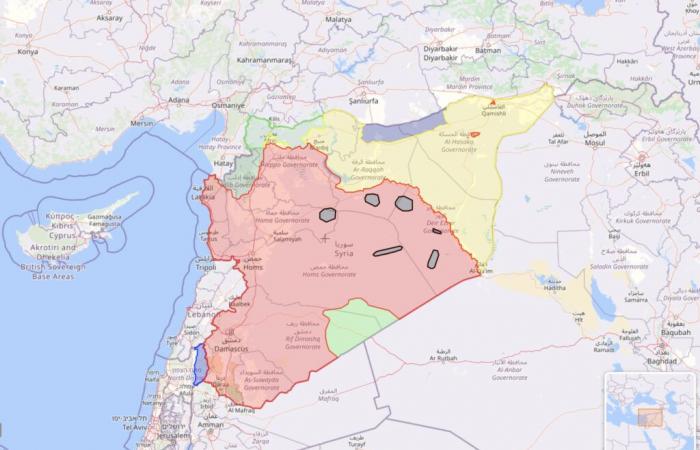On September 17 and 18, 2023, more than 3,000 pagers and walkie-talkies used by Hezbollah exploded. Particularly shocking in their scale, these events constituted the prelude to the Israeli military operation against the Lebanese militia, and sounded the alarm both in Beirut and in Damascus.
A month earlier, the director of the general intelligence department of the Bashar Al-Assad regime, Major General Houssam Louqa, had made a secret visit to Beirut, where he met the deputy secretary general of Hezbollah, Naïm Qassem. Louqa had asked Hezbollah to reduce the escalation and not fall into the Israeli trap, given the military risk for both the Lebanese militia and the Syrian regime. Qassem highlighted Hezbollah's step-by-step, thoughtful strategy as well as Israel's wear and tear after a year of war in the Gaza Strip.
Naïm Qassem and Hassan Nasrallah in fact made an error of judgment by dismissing the risk of an Israeli offensive. The second was assassinated on September 27, and the Assad regime found itself facing its most complex challenge since the outbreak of the Syrian revolution in March 2011, with control of the Syrian-Lebanese border at stake. strategic importance for Hezbollah and the Iranians, but also for Israel.
The central role of Hezbollah
Iranian leaders believe that a crushing defeat of Hezbollah would have negative consequences for their own national security. The existence of the Lebanese group until then provided a deterrent for Iran and its nuclear program, as the first line of confrontation and an asset for blackmail on the part of Tehran towards Israel and the United States. The militia has also played a role in providing technical and logistical support to Iranian-backed militias in Iraq and Houthis in Yemen. Hezbollah also helped save the Assad regime in the early years of the revolution against him, especially between 2012 and 2015. Tehran therefore considers that the rout of Hezbollah would present a risk for its national security and, in particular, for its nuclear program against Israel. This is why continued support for Hezbollah via the Syrian-Lebanese border is a strategic priority, whatever the cost. A cost that especially worries Bashar Al-Assad, whose eyes are fixed on Israel.
On the Israeli side, two issues are priorities in the Syrian theater. The first concerns the Syrian-Lebanese border and the second concerns Iranian-backed militias in Syria. These concerns could become more intense given the refusal of Tehran and Hezbollah to accept defeat and make concessions prompting the Israeli government to end its military operation in Lebanon. Tel Aviv is, however, aware of the difficulty in continuing its offensive in the short term, after the American presidential election, despite the re-election of Donald Trump. Hence the decision to attack the porosity of the Syrian-Lebanese border, as evidenced by the recent declaration of Israeli Prime Minister Benjamin Netanyahu: « We will cut Hezbollah's oxygen pipeline from Iran to Syria1. »
Three military scenarios
In practice, three military scenarios are on the table of the Israeli government to obstruct this border. The first consists of extending the Israeli military land offensive on Lebanese territory towards the Bekaa plain, the Baalbek and Hermel regions, to control the border. This scenario appears very costly and complex.
The second consists of launching a new land offensive to the southwest of Syrian territory, towards Quneitra, then towards the west of Damascus, towards Qalamoun and Homs, in order to close the border on the Syrian side. This scenario is constrained by the Russian presence in Syria and its costs would be high due to the strong presence of militias supported by Iran.
The third would be for Israel to intensify its airstrikes on both sides of the border. Since the start of the operation against Hezbollah, the Israeli air force has carried out dozens of airstrikes targeting official or unofficial crossing points on the Syrian-Lebanese border. Israel also assassinated three leaders of Unit 4400, affiliated with Hezbollah and responsible for financing and supplying the group from Syrian territory, the most important of which, Muhammad Jaafar Qasir, was a close staff member of Bashar Al-Assad. But the effectiveness of these strikes appears to have been limited.
Based on this observation, Israel warned Assad of the need to take the decision to close these borders. But the latter has not yet responded to this warning, and for good reason.
The Syrian archipelago
Legend :
In red: area controlled by Bashar Al-Assad
In green and gray: Afrin and Tal Abyad-Serekeniye, area controlled by Turkey
In dark green: Idleb, area controlled by Hay'at Tahrir Al-Sham (HTC)
In yellow: the area controlled by the Syrian Democratic Forces (FDS)
At the mercy of Tehran
After the outbreak of the Syrian revolution, Iran intervened militarily and directly protected Assad. Building on its support for military figures seeking important positions and its relationships with the leaders of the security services, its influence has grown within the Syrian regime itself. Tehran has also strengthened its relations with the main Syrian entrepreneurs close to the regime. This interference occurred alongside the sending into the field of thousands of Iranian-backed militia fighters from Iraq and Lebanon. Thus, Iran gradually moved from the status of an ally protecting Assad to that of a partner in territorial management. This reality forces Assad to think carefully before taking any steps that would thwart Iranian interests, including in areas under his control. A possible conflict on a strategic issue with Iranian leaders could have serious repercussions on the security and economic situation in Syria and, possibly, on Assad himself. Based on these concerns, Assad is knocking on Russia's door.
This is not the first time that Damascus has requested help from Moscow in a crisis in which Tehran is involved and which constitutes a threat to the stability of the Syrian regime. In his book The lost novel, the former Syrian vice-president responsible for foreign affairs, Farouk Al-Sharah, discusses Hafez al-Assad's reaction after the outbreak of the first Gulf War between Iraq and Iran (1979-1989):
Hafez Al-Assad rushed to sign the Treaty of Friendship and Cooperation between Syria and the Soviet Union on October 8, 1980, which he had always been reluctant to sign. This approach constitutes a response to this new variable.
During a surprise visit to Moscow in July 2023, Bashar Al-Assad met with Russian President Vladimir Putin, who told him that the regional situation was deteriorating and that Syria was directly concerned. However, Russia, despite the war in Ukraine and strategic cooperation with Tehran, still maintains close relations with Israel. Hence Assad's fundamental question in his Syrian-Lebanese border dilemma: will Moscow side with Tehran, Tel Aviv or Damascus? ?
On September 8, in the Masyaf region, Israeli helicopters carried out a military operation against an Islamic Revolutionary Guard Corps facility, presumably manufacturing warheads for ballistic missiles. At the Russian base at Hmeimim, located just a few kilometers from this area, a cautious calm reigned. The base's S-400 air defense batteries, although having identified the Israeli kinetics, showed no reaction. This is consistent with how Moscow has historically tolerated Israeli airstrikes against Iranian interests in Syria. The Russians distinguish their interests in this country from those of Tehran, with the priority being the maintenance of the Syrian regime, and the preservation of their military bases on the Syrian coast, their only outlet to the Mediterranean Sea. Hence the lack of notable reaction from Russia.
Kremlin maps
The Soviet Union was not on Iran's list of allies before or after Ayatollah Ruhollah Khomeini came to power. During the first Gulf War between Iran and Iraq, the Soviet Union did not provide equipment to Tehran, but supported Baghdad, supplying it with fighter planes, missiles and munitions. It now appears that Moscow and Tehran have a more complex relationship than their politicians let on. Putin affirms that the Islamic Republic is a strategic ally of Russia, and the Guide of the Revolution Ali Khamenei emphasizes the friendship with Moscow as well as their rapprochement in the face of “ the West “. However, behind these statements, contradictions emerge. For example, regarding the Russian invasion of Ukraine, Tehran supports Moscow in a significant way, by providing medium and long-range missiles, drones, and ensuring the transfer of technology to manufacture these drones in Russia. But in Yemen, this alliance is different in nature. Despite repeated requests from the Iranians and the Houthis for the supply of Russian-made Yakhont surface-to-sea missiles, Moscow is still hesitant. This hesitation is also reflected in the supply to Tehran of the S-400 system, which the Iranians still hope to obtain from the Kremlin urgently, particularly after the Israeli airstrike on October 26. Russia justifies its posture by the complexity of the situation. Relations between Russia and Iran therefore change depending on the file, including in the Syrian theater, where Moscow remains in the background on the Iranian-Israeli conflict.
By connecting the wires coming from Tehran, Moscow and Tel Aviv to Damascus, Syria finds itself facing an equation that threatens the stability of the Muhajirine Palace (the Syrian presidential palace). The Iranians believe that obstructing the Syrian-Lebanese border will hasten Hezbollah's defeat and threaten their national security. For their part, the Israelis know that to weaken Hezbollah and prevent it from reestablishing its military capabilities, Assad must close its border with Lebanon. The Russians are not ready to intervene in this conflict. They therefore at least try to understand the designs of each of the two parties without taking concrete measures, whether to serve as mediator or, if necessary, to support one of the parties against the other. Assad finds himself alone between an ally who pushes him into the abyss, another who observes the scene from a distance and a neighbor who is resolutely serious in his threats.
Assad's Syria is trapped between these three parties. The assassination of Hassan Nasrallah by the Israelis and that of former Yemeni President Ali Abdallah Saleh on December 4, 2017 by the Houthis – undoubtedly with Iranian approval – fuel the latter's fears. Not to mention that Israelis consider Assad more than ever, not as a president useful to their interests, but as a threat to their national security and their regional projects. But the decision to get rid of it is only possible with the approval of Russian President Vladimir Putin.
The articles presented on our site are subject to copyright. If you wish to reproduce or translate an article from Orient XXI, please contact us first to obtain authorization from the author(s).
- -





